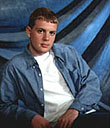|
|
This topic comprises 3 pages: 1 2 3
|
|
Author
|
Topic: Flicker on an older simplex
|
|
|
|
|
|
|
|
|
John Pytlak
Film God

Posts: 9987
From: Rochester, NY 14650-1922
Registered: Jan 2000
|
 posted 11-13-2001 08:08 AM
posted 11-13-2001 08:08 AM





With a two blade shutter, a slight amount of (48 Hz) flicker can normally still be perceived, expecially in really bright areas of the picture or with no film in the projector. A three-blade shutter virtually eliminates perceived flicker by raising the frequency to 72 Hz.If your projector was operating much below 24fps, the effect on sound would be obvious. It's highly unlikely the projector motor is slow enough to cause the flicker, unless the analog sound varies in pitch or is obviously too low in pitch. If in doubt, measure out exactly 1440 frames of film (24 x 60 = 1440) and verify that it takes exactly 60 seconds to project it when the projector is at "speed". Excessive current ripple in the direct current supplied to the lamphouse will definitely increase flicker and reduce xenon lamp life. 60Hz power supply ripple "beats" with the 48Hz or 72Hz shutter frequency to produce an annoying and very visible 12Hz flicker component. Diode failure, mismatched voltage on the incoming 3-phase power (worn, overheated, or oxidized contacts?), or deteriorating filter components are the most likely causes. Instability of the arc plasma or vibration of the lamphouse optical components can produce an irregular "candlelight" flicker. The arc plasma can become unstable as the lamp nears the end of its' life, or is subjected to uneven/excessive ventilation or magnetic fields. Look at the lamp through the sight glass of the lamphouse and observe whether the plasma "arc" is stable, or if moves around erratically like a candle flame. Osram recommends measuring current ripple by analyzing the voltage drop across a low-induction shunt with an oscilloscope (DANGER: do not attempt this unless you understand how to properly measure high power circuits), or by letting a bit of light directly from the lamp shine on a photocell and analyzing the variation in light output with an oscilloscope. The Osram booklet "XBO Theatre Lamps (Reference-No. 123 W97E 11/97)", available direct from OSRAM Public Relations in Munich or via FOMK-B, outlines the procedure. Here are links to xenon lamp information:
http://www.osram.com/service_corner/download_center/photo.html#XBO
http://www.cinemaequip.com/tech4.shtml
http://www.xenonbulbs.com/pdf_manuals/xenon_bulb_info/xenon_bulb_failure_analysis.pdf[/UR L]
[URL=http://www.ltilamps.com/Media/xe_tech_article.pdf]http://www.ltilamps.com/Media/xe_tech_article.pdf ------------------
John P. Pytlak, Senior Technical Specialist
Worldwide Technical Services, Entertainment Imaging
Research Labs, Building 69, Room 7525A
Rochester, New York, 14650-1922 USA
Tel: 716-477-5325 Cell: 716-781-4036 Fax: 716-722-7243
E-Mail: john.pytlak@kodak.com
Web site: http://www.kodak.com/go/motion
| IP: Logged
|
|
Pat Moore
Master Film Handler

Posts: 363
Registered: Mar 2000
|
 posted 11-13-2001 10:19 AM
posted 11-13-2001 10:19 AM




Hi;"Flicker" implies a flashing or a pulsing pattern of light on screen, such as would come from diode problems or something with the shutter. "Arc Waver" will cause a moving pattern of light on screen as the plasma ball searches for a "happy spot" at the cathode tip. Waver would also show up if the flame of the arc is moving around on the anode of the lamp. I don't think projector speed is your problem -- it would have to be really slow to be noticeable unless there is a LOT of light on the screen, as John notes above. One other thing to look at: Some of those lamphouses were a bit notorious for allowing the reflector to vibrate in it's holder. This can cause some really funny light patterns on screen. The vibration is usually caused by a bulb seal blower that's dirty and out of balance. Seems like Kneisley also held the reflector in with spring clips to allow the reflector to expand -- are they secure? Pat
| IP: Logged
|
|
|
|
|
|
|
|
|
|
|
|
|
|
|
|
|
|
|
|
|
|
All times are Central (GMT -6:00)
|
This topic comprises 3 pages: 1 2 3
|
Powered by Infopop Corporation
UBB.classicTM
6.3.1.2
The Film-Tech Forums are designed for various members related to the cinema industry to express their opinions, viewpoints and testimonials on various products, services and events based upon speculation, personal knowledge and factual information through use, therefore all views represented here allow no liability upon the publishers of this web site and the owners of said views assume no liability for any ill will resulting from these postings. The posts made here are for educational as well as entertainment purposes and as such anyone viewing this portion of the website must accept these views as statements of the author of that opinion
and agrees to release the authors from any and all liability.
|

 Home
Home
 Products
Products
 Store
Store
 Forum
Forum
 Warehouse
Warehouse
 Contact Us
Contact Us




 Printer-friendly view of this topic
Printer-friendly view of this topic
















